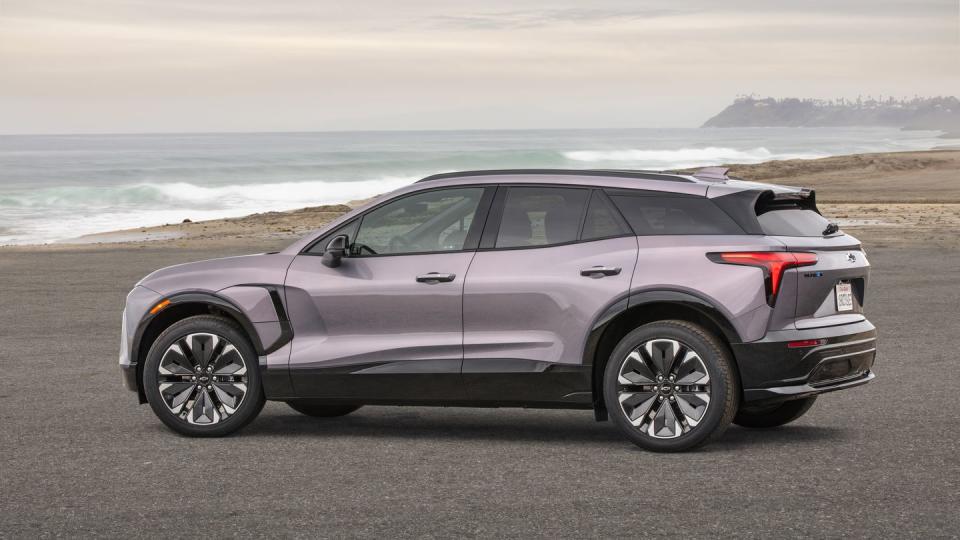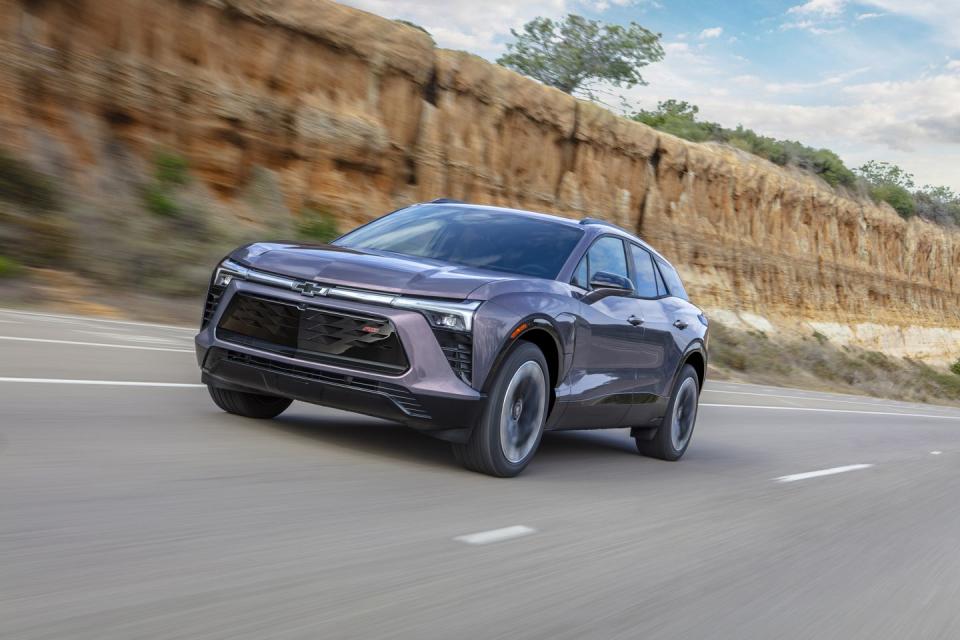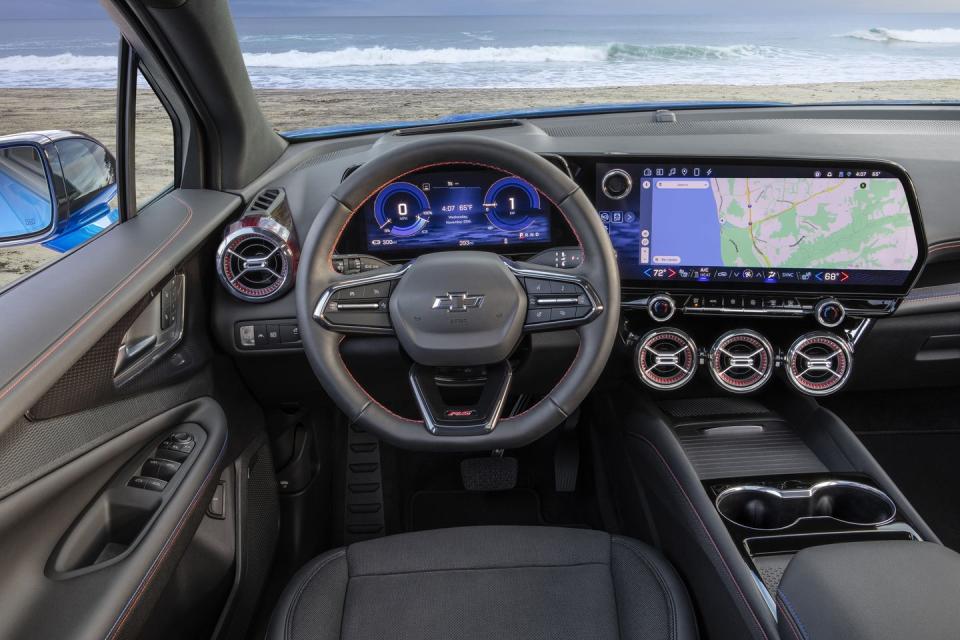How the 2024 Chevrolet Blazer EV Stacks Up against Its Competition

2024 Chevrolet Blazer EV offers a roomy interior, tight handling, and can go up to 320 miles on a charge.
Three trim levels include LT, RS, and SS, with rear- or all-wheel-drive versions available depending on trim.
Prices start as low as $44,995. Some models are in showrooms now.
Are electric vehicles going to take over the planet, or has all this EV stuff plateaued, even fizzled out? We will know by 2035, or maybe 2050. For now, some manufacturers are plugging into it more than others. Chevrolet, for instance, has just introduced what could be its biggest-selling EV since the Bolt: the 2024 Blazer EV.
GM estimates that of all future electric vehicle sales, SUVs will make up more than two thirds, or 64%; cars will make up 30%, and trucks just 6%. Hence, the Blazer EV.
Apart from the name, this midsize crossover shares nothing else with the internal-combustion-powered Blazer of the same name (which will continue to be made for the foreseeable future, btw). The Blazer EV rides on GM’s much-touted Ultium platform, a setup that, in this application, accommodates battery packs of 85 and 102 kWh. It comes in three models: LT, RS, and SS. It’s the first Chevrolet EV to get an SS model.

What It’s Like to Drive
Last week I got to drive a couple of mid-level RS models, the RWD and the eAWD. The RWD has a single permanent-magnet motor driving the rear wheels and making 250 kW, or 335 hp. That motor is shared with the stylish Cadillac Lyriq.
The eAWD takes that big motor, retunes it a little, and moves it to the front axle, then adds a small induction motor to the rear axle that only comes on when you get stuck in the snow or otherwise lose grip.
The Blazer EV RS AWD I drove is rated at 279 miles EPA-certified range while its power is listed by Chevy at 288 hp and 333 lb ft. Chevy listed price as tested for that model RS AWD at $60,215.
On a few drive loops in the Greater San Diego area, for most of the drive I couldn’t tell the difference between the two. Since the rear induction motor only kicks in when there’s slip, and since there was no slip on the sunny SoCal streets, that seeming similarity was understandable.
If you really pushed it, say exiting a tight corner, you’d start to feel the difference. But that would require either an autocross course or reckless abandon to really exploit, neither of which I had that day. For the most part, power output of the two RS drivetrains is practically the same.
Now, if you can hang on till some point in 2024, you can get two more drivetrains: the entry-level FWD 1LT and 2LT Blazers EV making 288 hp and 333 lb-ft of torque; and the mighty and powerful SS. I didn’t drive either of those but there’s no doubt the SS will be the flagship of the line with 557 hp and 648 lb-ft of torque and a 0-60-mph time of “under 4 seconds” in the SS-specific WOW mode, which temporarily adds 129% power.
The SS will get pAWD, wherein the p stands for permanent, as opposed to the eAWD where the tiny induction motor in the rear only comes on when needed. The SS gets two big permanent-magnet bar-wound motors. It also gets the larger 102-kWh battery, though range wasn’t listed yet, nor was price.
As is always the case, there’s a range of ranges. The AWD models with the 85-kWh batteries get EPA certified range of 279 miles, while the RWD model with the 102-kWh battery gets 324 miles.
Charging is likewise pretty quick. At DC fast-charging Level 3 hookups, the 85 kWh battery can charge at up to 150 kW, good for 69 miles range in 10 minutes in an RS AWD. The 102-kWh battery can charge at 190 kW, or 78 miles of range in 10 minutes. That’s all assuming you can find a working charger, haha. Home charging on Level 2 at 240 volts, meanwhile, can handle 11 kW.
How It Stacks Up
By transparent coincidence, that week I was driving a Kia EV6 GT. The Kia felt smaller and a little looser from behind the wheel. The Blazer was wider in the beam and felt tighter all around. Chevy listed competitors for the Blazer EV as the Ford Mustang Mach-e, Tesla Model Y, and Hyundai Ioniq 5. You’d probably be better off test-driving them all, but I might give the nod to the Blazer.

One reason to like the Chevy is its big, horizontal 17.7-inch diagonal infotainment screen. This one looked very similar to the one in the Kia but seemed to be laid out a little better, with Google Assistant, Google Maps, and Google everything else. The voice recognition seemed to work better than the Kia, and the layout of the icons was easier to maneuver.
You can customize the screen quite handily. Navigating to anywhere using the Blazer EV easily integrates charging stations. Google Navigation shows your route plus the best charging stations to use on the way, when and where you need them. You can pick which stations to prioritize in your search, too, so if you like Electrify America, you can pick all EA stations, etc.
Pricing
The 2024 Chevrolet Blazer EV 2LT and RS go on sale in summer 2023, priced starting around $47,595 and $51,995, respectively. The SS follows later in 2023, priced starting around $65,995, followed by the 1LT and the PPV fleet model (Police Pursuit Vehicle!) in Q1 2024. The 1LT will be priced starting around $44,995. I’d get the 1LT, especially considering these will almost all be used in placid suburbia.
Is the future going to be all-electric? Who knows? Get one of these Blazer EVs and be your own decision-making influencer.


 Yahoo Autos
Yahoo Autos 